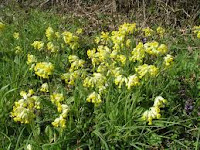White dead nettles are so-called because although they resemble the stinging nettle very closely, they don’t sting. They are not true nettles in the Uriotica genus, but a separate genus in the Lamiaceae or Labiatae family. This makes them relatives of mint, clown's woundwort, marjoram, basil, Holy basil, oregano, savory, thyme, lavender, lemon balm, as well as bugle, motherwort, self-heal, catnip, the chaste tree, ground ivy, Jupiter’s sage, wall germander, Fragrant premna and hyssop. In Nicholas Culpeper’s time (17th century) they were classes as one of the Archangels along with the purple and the yellow deadnettle.
This white dead nettle is also called the Bee Nettle because bees love it. Their stems are hollow and square, unlike those of the stinging nettle, and were called Archangels because they thought they flowered on Archangel Michael’s day which was May 8th in the Julian calendar but would be April 28th now. “Laimos” is an ancient Greek word meaning throat, which refers to the shape of the flowers – take a close look at the pictures to see the resemblance. The plant has astringent properties and edible leaves and flowers. The leaves can be eaten raw in salads or cooked like spinach. They can also be used to flavour soups and stews. You can make a tisane with the flowering tops which is said to be an excellent tonic (containing vitamin A) and which acts as a blood purifier and to help with menstrual problems.
The leaves and flowers are used in a hot compress for piles and varicose veins, while the distilled water of the flowers has been used traditionally as an eye lotion. The flowering tops have been used for bladder and kidney problems too. The herb is best harvested in summer when it is flowering and it does so between May to December, although may come into bloom earlier, depending on where you live.
It has been used to induce sleep, and the flowers boiled in water were used for bronchial problems while the roots, boiled in wine were used to disperse kidney stones. They are currently used for benign prostate hyperplasia (BPH) and leucorrhoea as well as for gastro-intestinal problems.
The English herbalist, Nicholas Culpeper, has this to say of the Archangels:
“Virtues and use. The archangels are somewhat hot and drier than the stinging nettles, and used with better success for the stopping and hardness of the spleen than they, by using the decoction of the herb in wine, and afterwards applying the herb hot into the region of the spleen as a plaister, or the decoction with spunges. Flowers of the white archangel are preserved or conserved to be used to stay the whites, and the flowers of the red to stay the reds in women. It makes the head merry, drives away melancholy, quickens the spirits, is good against quartan agues, stancheth bleeding at mouth and nose, if it be stamped and applied to the nape of the neck; the herb also bruised, and with some salt and vinegar, and hog-grease, laid upon an hard tumour or swelling, or that vulgarly called the king's evil, do help to dissolve or discuss them; and being in like manner applied, doth much allay the pains, and give ease to the gout, sciatica, and other pains of the joints and sinews. It is also very effectual to heal green wounds, and old ulcers; also to stay their fretting, gnawing and spreading. It draweth forth splinters, and such like things gotten into the flesh, and is very good against bruises and burnings. But the yellow archangel is most commended for old, filthy, corrupt sores and ulcers, yea, although they grow to be hollow, and to dissolve tumours.”
It has been found that the aqueous extract of the flowering tops and the lamiridosins of the white dead nettle is effective against the Hepatitis C virus, and there are ongoing studies into its possible other medicinal benefits.


































